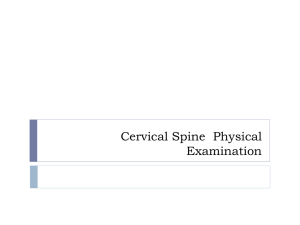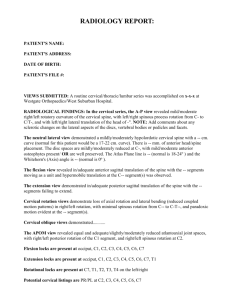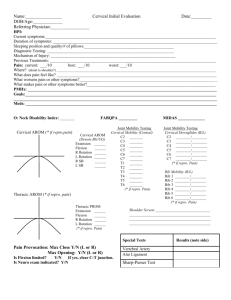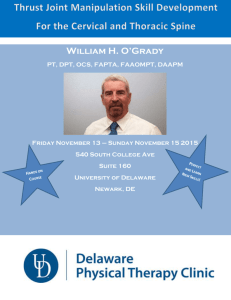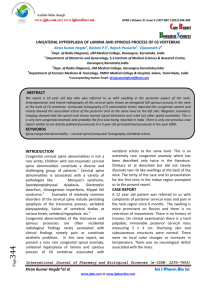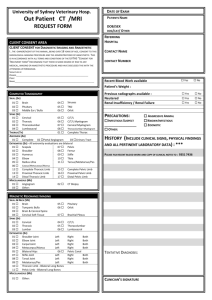Cervical Spine joints
advertisement
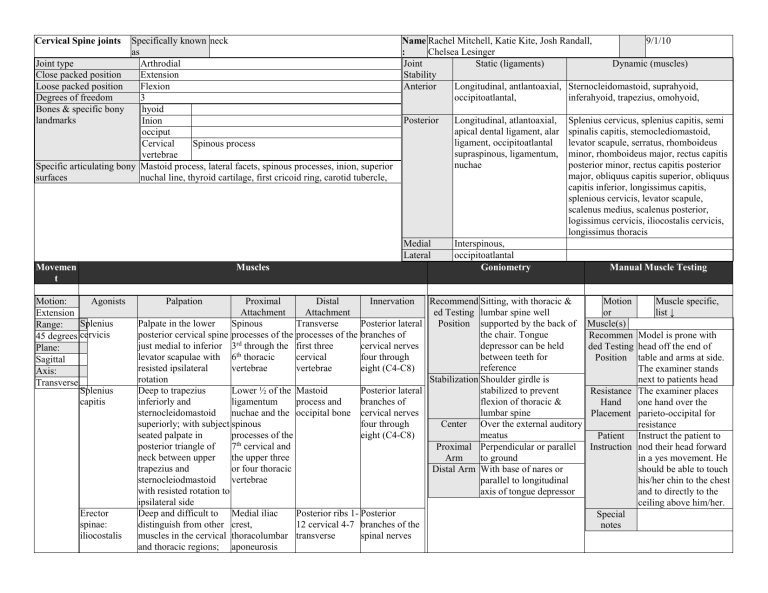
Specifically known neck 9/1/10 Name Rachel Mitchell, Katie Kite, Josh Randall, as Chelsea Lesinger : Joint type Arthrodial Joint Static (ligaments) Dynamic (muscles) Close packed position Extension Stability Loose packed position Flexion Anterior Longitudinal, antlantoaxial, Sternocleidomastoid, suprahyoid, Degrees of freedom 3 occipitoatlantal, inferahyoid, trapezius, omohyoid, Bones & specific bony hyoid landmarks Posterior Longitudinal, atlantoaxial, Splenius cervicus, splenius capitis, semi Inion apical dental ligament, alar spinalis capitis, stemoclediomastoid, occiput ligament, occipitoatlantal levator scapule, serratus, rhomboideus Cervical Spinous process supraspinous, ligamentum, minor, rhomboideus major, rectus capitis vertebrae nuchae posterior minor, rectus capitis posterior Specific articulating bony Mastoid process, lateral facets, spinous processes, inion, superior major, obliquus capitis superior, obliquus surfaces nuchal line, thyroid cartilage, first cricoid ring, carotid tubercle, capitis inferior, longissimus capitis, splenious cervicis, levator scapule, scalenus medius, scalenus posterior, logissimus cervicis, iliocostalis cervicis, longissimus thoracis Medial Interspinous, Lateral occipitoatlantal Movemen Muscles Goniometry Manual Muscle Testing t Cervical Spine joints Agonists Motion: Extension Splenius Range: 45 degrees cervicis Plane: Sagittal Axis: Transverse Splenius capitis Erector spinae: iliocostalis Palpation Proximal Distal Innervation Recommend Sitting, with thoracic & Attachment Attachment ed Testing lumbar spine well Position supported by the back of Palpate in the lower Spinous Transverse Posterior lateral the chair. Tongue posterior cervical spine processes of the processes of the branches of depressor can be held just medial to inferior 3rd through the first three cervical nerves between teeth for levator scapulae with 6th thoracic cervical four through reference resisted ipsilateral vertebrae vertebrae eight (C4-C8) rotation Stabilization Shoulder girdle is stabilized to prevent Deep to trapezius Lower ½ of the Mastoid Posterior lateral flexion of thoracic & inferiorly and ligamentum process and branches of lumbar spine sternocleidomastoid nuchae and the occipital bone cervical nerves superiorly; with subject spinous four through Center Over the external auditory seated palpate in processes of the eight (C4-C8) meatus posterior triangle of 7th cervical and Proximal Perpendicular or parallel neck between upper the upper three Arm to ground trapezius and or four thoracic Distal Arm With base of nares or sternocleiodmastoid vertebrae parallel to longitudinal with resisted rotation to axis of tongue depressor ipsilateral side Deep and difficult to Medial iliac Posterior ribs 1- Posterior distinguish from other crest, 12 cervical 4-7 branches of the muscles in the cervical thoracolumbar transverse spinal nerves and thoracic regions; aponeurosis Motion Muscle specific, or list ↓ Muscle(s) Recommen Model is prone with ded Testing head off the end of Position table and arms at side. The examiner stands next to patients head Resistance The examiner places Hand one hand over the Placement parieto-occipital for resistance Patient Instruct the patient to Instruction nod their head forward in a yes movement. He should be able to touch his/her chin to the chest and to directly to the ceiling above him/her. Special notes with subject prone, palpate immediately lateral to spinous processes in lumbar region with active extension Erector spinae: longissimus Erector spinae: Spinalis Motion: Rotation Range: 60 degrees Plane: Transvers e Axis: Vertical Agonists Splenius cervicis Splenius capitis from sacrum, posterior ribs 312 Medial iliac Cervical 2-6 Posterior crest, spinous branches of the Deep and difficult to thoracolumbar processes spinal nerves distinguish from other from sacrum, thoracic 1-12 muscles in the cervical lumbar 1-5 transverse and thoracic regions; transverse processes lower with subject prone, processes, and 9 ribs, mastoid palpate immediately thoracic 1-5 process lateral to spinous transverse processes in lumbar processes, region with active cervical 5-7 extension articular processes Deep and difficult to Ligamentum 2nd cervical Posterior distinguish from other nuchae, 7h spinous branches of the muscles in the cervical cervical spinous process, spinal nerves and thoracic regions; process, thoracic 5-12 with subject prone, thoracic 11-12 spinous palpate immediately spinous processes, lateral to spinous processes, occipital bone processes in lumbar andlumbar1-2 region with active spinous extension processes Palpation Proximal Distal Innervation Recommend Sitting, with thoracic & Attachment Attachment ed Testing lumbar spine well Palpate in the lower Spinous Transverse Posterior lateral Position supported by the back of the chair. Cervical spine posterior cervical spine processes of the processes of the branches of in 00 of flex, ext, & lat just medial to inferior 3rd through the first three cervical nerves th flex. Tongue depressor levator scapulae with 6 thoracic cervical four through can be held between teeth resisted ipsilateral vertebrae vertebrae eight (C4-C8) for reference. rotation Deep to trapezius Lower ½ of the Mastoid Posterior lateral Stabilization Shoulder girdle is stabilized to prevent inferiorly and ligamentum process and branches of rotation of thoracic & sternocleidomastoid nuchae and the occipital bone cervical nerves lumbar spine. superiorly; with subject spinous four through seated palpate in processes of the eight (C4-C8) Center Over center of cranial posterior triangle of 7th cervical and aspect of head neck between upper the upper three Proximal Parallel to imaginary line trapezius and or four thoracic Arm between the two acromial sternocleiodmastoid vertebrae processes Motion Muscle specific, or list ↓ Muscle(s) Recommen Patient is supine with ded Testing head supported on table Position and turned to the right to test the left sternocleidomastoid. Resistance Therapist faces the Hand patient with one hand Placement placed on the temporal area above the ear for resistance. Patient To rotate his/her head Instruction in a “no” motion toward the open palm of the resisting hand. Motion: Lateral flexion Range: 45 with resisted rotation to Distal Arm With the tip of the nose. If Special ipsilateral side using tongue depressor, notes parallel to longitudinal Sternocleidom Anterrolateral neck, Manubrium of Mastoid Spinal axis of tongue depressor astoid (both diagonally between the sternum, process accessory (Cr sides) origin and insertion, anterior 11, C2-C3) particularly with superior surface rotation to contralateral medial clavicle side Erector spinae: Deep and difficult to Medial iliac Posterior ribs 1- Posterior iliocostalis distinguish from other crest, 12 cervical 4-7 branches of the muscles in the cervical thoracolumbar transverse spinal nerves and thoracic regions; aponeurosis with subject prone, from sacrum, palpate immediately posterior ribs 3lateral to spinous 12 processes in lumbar region with active extension Erector spinae: Medial iliac Cervical 2-6 Posterior longissimus crest, spinous branches of the Deep and difficult to thoracolumbar processes spinal nerves distinguish from other from sacrum, thoracic 1-12 muscles in the cervical lumbar 1-5 transverse and thoracic regions; transverse processes lower with subject prone, processes, and 9 ribs, mastoid palpate immediately thoracic 1-5 process lateral to spinous transverse processes in lumbar processes, region with active cervical 5-7 extension articular processes Erector spinae: Deep and difficult to Ligamentum 2nd cervical Posterior Spinalis distinguish from other nuchae, 7h spinous branches of the muscles in the cervical cervical spinous process, spinal nerves and thoracic regions; process, thoracic 5-12 with subject prone, thoracic 11-12 spinous palpate immediately spinous processes, lateral to spinous processes, occipital bone processes in lumbar andlumbar1-2 region with active spinous extension processes Agonists Palpation Proximal Distal Innervation Recommend Sitting, with thoracic & Motion Muscle specific, Attachment Attachment ed Testing lumbar spine well or list ↓ Splenius cervicis Palpate in the lower Spinous Transverse Posterior lateral Position supported by the back of Muscle(s) Sternocleidomastoid the chair. Cervical spine Recommend posterior cervical processes of the processes of the branches of in 00 of flex, ext, & rot. spine just medial to 3rd through the first three cervical nerves ed Testing degrees Plane: Frontal Axis: sagittal inferior levator 6th thoracic cervical four through Tongue depressor can be Position scapulae with resisted vertebrae vertebrae eight (C4-C8) held between teeth for Resistance ipsilateral rotation reference. Hand Splenius capitis Deep to trapezius Lower ½ of the Mastoid Posterior lateral Stabilization Shoulder girdle is Placement inferiorly and ligamentum process and branches of stabilized to prevent Patient sternocleidomastoid nuchae and the occipital bone cervical nerves lateral flexion of thoracic Instruction superiorly; with spinous four through & lumbar spine subject seated palpate processes of the eight (C4-C8) Center Over spinous process of in posterior triangle 7th cervical and C7 of neck between the upper three Proximal Spinous processes of Special notes upper trapezius and or four thoracic Arm thoracic vertebrae so that sternocleiodmastoid vertebrae arm is perpendicular to with resisted rotation ground to ipsilateral side Distal Arm Dorsal midline of head. Erector spinae: Deep and difficult to Medial iliac Posterior ribs 1- Posterior Reference occipital iliocostalis distinguish from other crest, 12 cervical 4-7 branches of the protuberance. muscles in the thoracolumbar transverse spinal nerves cervical and thoracic aponeurosis regions; with subject from sacrum, prone, palpate posterior ribs 3immediately lateral to 12 spinous processes in lumbar region with active extension Erector spinae: Medial iliac Cervical 2-6 Posterior longissimus crest, spinous branches of the Deep and difficult to thoracolumbar processes spinal nerves distinguish from other from sacrum, thoracic 1-12 muscles in the lumbar 1-5 transverse cervical and thoracic transverse processes lower regions; with subject processes, and 9 ribs, mastoid prone, palpate thoracic 1-5 process immediately lateral to transverse spinous processes in processes, lumbar region with cervical 5-7 active extension articular processes Erector spinae: Deep and difficult to Ligamentum 2nd cervical Posterior Spinalis distinguish from other nuchae, 7h spinous branches of the muscles in the cervical spinous process, spinal nerves cervical and thoracic process, thoracic 5-12 regions; with subject thoracic 11-12 spinous prone, palpate spinous processes, immediately lateral to processes, occipital bone spinous processes in andlumbar1-2 lumbar region with spinous Resistant range of motion Have the patient to try to touch his/her ear to the shoulder making sure he does not lift the shoulder. Larger cervical lymph nodes may cause limited motion. processes Posterior inner Approximately Branches of lip of the iliac on half the T12, L1 nerves crest length of the lower border of the 12th rib and the transverse process of the upper four lumbar vertebrae Sternocleidomast Anterrolateral neck, Manubrium of Mastoid Spinal oid (both sides) diagonally between sternum, process accessory (Cr the origin and anterior 11, C2-C3) insertion, particularly superior surface with rotation to medial clavicle contralateral side Agonists Palpation Proximal Distal Innervation Recommend Sitting, with thoracic & Motion: Attachment Attachment ed Testing lumbar spine well Flexion Position supported by the back of Sternocleidomast Anterrolateral neck, Manubrium of Mastoid Spinal Range: the chair. Tongue process accessory (Cr 45 degrees oid (both sides) diagonally between sternum, depressor can be held the origin and anterior 11, C2-C3) Plane: between teeth for insertion, particularly superior surface Sagittal reference with rotation to medial clavicle Axis: contralateral side Stabilization Shoulder girdle is Transverse stabilized to prevent flexion of thoracic & lumbar spine Center Over the external auditory meatus Proximal Perpendicular or parallel Arm to ground Distal Arm With base of nares or parallel to longitudinal axis of tongue depressor Quadratus lumborum active extension With subject prone just superior to iliac crest and lateral to lumbar erector spinae with isometric lateral flexion Motion Muscle specific, or list ↓ Muscle (s) Recommen Model is supine with ded Testing arms at their side, and Position head on table. The examiner stands next to patients’ head. Resistance The examiner places Hand one hand on the Placement model's forehead for resistance Patient Instruct the patient Instruction to nod their head forward in a yes movement. He should be able to touch his/her chin to the chest and to directly to the ceiling above him/her. Special notes As he moves his head, watch to see if the arc of motion is smooth rather halting.
